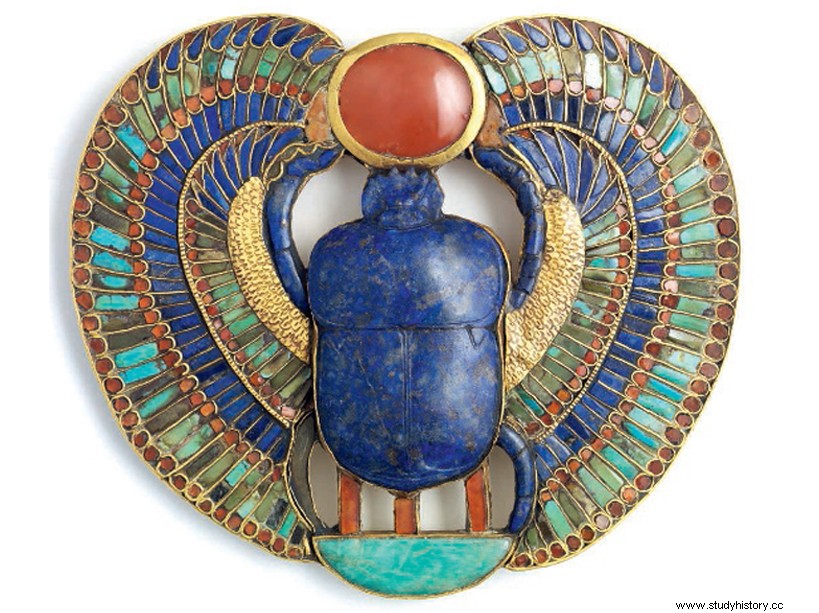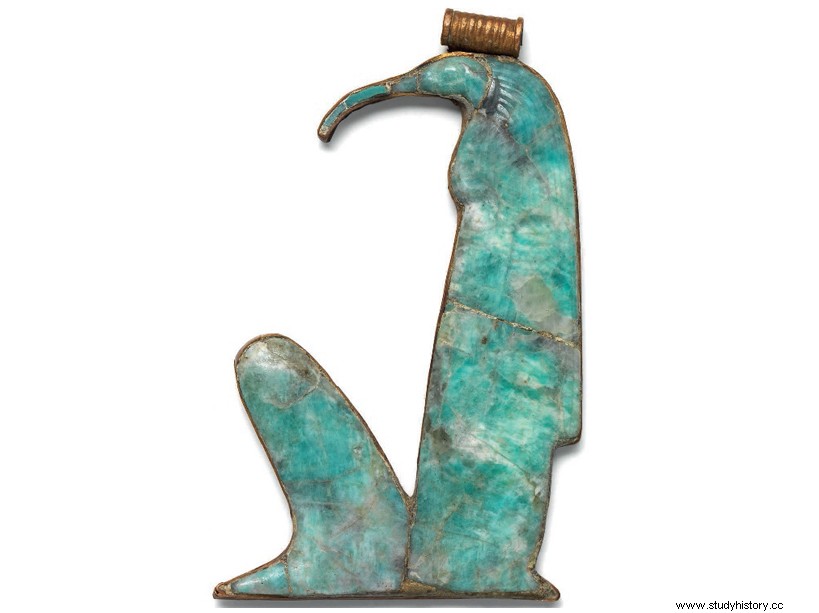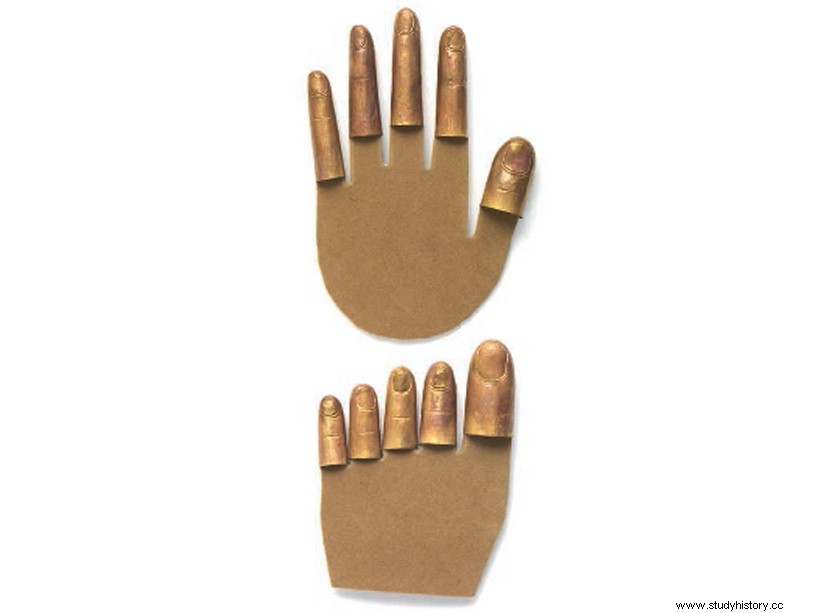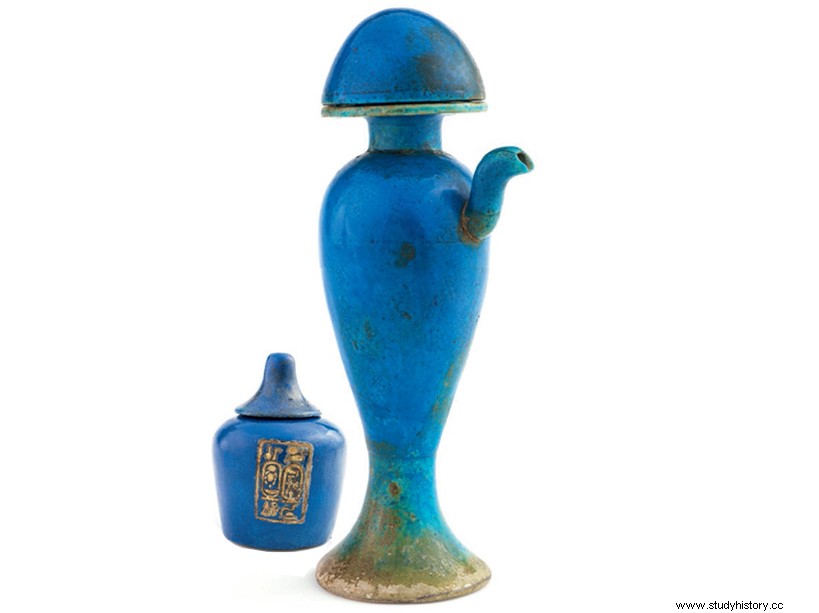Tutankhamun's tomb - the only one found almost intact in Egypt - has yielded many refined objects, essential for the journey to the afterlife. And moving testimonies of the king's short earthly life. An excerpt from Sciences et Avenir special edition 197

Like other pieces of his funerary furniture, Tutankhamun's sarcophagus may not have been designed for him. The teenager's sudden death is said to have forced priests and dignitaries to award him treasures prepared for another.
For technical and political reasons - the British wanting to take half of the objects from the tomb, the Egyptians opposing it - Howard Carter did not open the coffin until 1925, almost three years after its discovery. Three years of suspense! He describes the operation in his memoirs:"With long screwdrivers, we gently removed the long solid gold nails which unfortunately had to be sacrificed, and then lifted the lid by its golden handles. Before our eyes, occupying the entire interior of the golden coffin lay an impressive neat and neat mummy, on whose body had been spread ointments, blackened and hardened by time.Contrasting to the dark color of the body, a magnificent mask of shiny gold, representing the face of the pharaoh, covered the head and shoulders. This incomparable mummy symbolized Osiris. The golden mask, a unique specimen of ancient art, had a sad but calm expression, suggesting youth prematurely caught in the death".
This discovery provides unpublished documentation not only on the funeral rites, but also on the daily life of a king. Starting with the objects placed in contact with the mummy:some 150 jewels and amulets buried in the strips of the shroud which covered it. Necklaces, bracelets, rings... were intended to form a bulwark against both looters and the forces of evil that lie in wait for the dead. The pectoral scarabs had a protective role, especially during the judgment of the soul at the court of Osiris:weighed, the heart had to be lighter than the feather of Maât, goddess of truth and justice, thus showing that it was not tainted with sins and that the deceased could join the kingdom of the dead. One of the scarabs was made of Libyan glass, a rare material, usually light green, sometimes transparent. Other amulets such as the tit - or knot of Isis - or real headrests were placed in the neck region to promote breathing. As for the fingers and toes in gold, they materialized the imputrescibility of the royal body.
This article by Sylvie Briet is taken from Sciences et Avenir special issue 197, dated April-May 2019, entitled "Egypt, the invention of eternity".
For technical and political reasons - the British wanting to take half of the objects from the tomb, the Egyptians opposing it - Howard Carter did not open the coffin until 1925, almost three years after its discovery. Three years of suspense! He describes the operation in his memoirs:"With long screwdrivers, we gently removed the long solid gold nails which unfortunately had to be sacrificed, and then lifted the lid by its golden handles. Before our eyes, occupying the entire interior of the golden coffin lay an impressive neat and neat mummy, on whose body had been spread ointments, blackened and hardened by time.Contrasting to the dark color of the body, a magnificent mask of shiny gold, representing the face of the pharaoh, covered the head and shoulders. This incomparable mummy symbolized Osiris. The golden mask, a unique specimen of ancient art, had a sad but calm expression, suggesting youth prematurely caught in the death".
This discovery provides unpublished documentation not only on the funeral rites, but also on the daily life of a king. Starting with the objects placed in contact with the mummy:some 150 jewels and amulets buried in the strips of the shroud that covered it.
Necklaces, bracelets, rings... were intended to form a bulwark against both looters and the forces of evil that lie in wait for the dead. The pectoral scarabs had a protective role, especially during the judgment of the soul at the court of Osiris:weighed, the heart had to be lighter than the feather of Maât, goddess of truth and justice, thus showing that it was not tainted with sins and that the deceased could join the kingdom of the dead. One of the scarabs was made of Libyan glass, a rare material, usually light green, sometimes transparent. Other amulets like the tit - or knot of Isis - or real headrests were placed in the neck region to promote breathing. As for the fingers and toes in gold, they materialized the imputrescibility of the royal body.
Some parts of the body had received special treatment:the viscera! Tied up and embalmed, stomach, liver, intestines and lungs were deposited in four miniature gold sarcophagi, placed in vases - called canopic vases - in alabaster whose almost identical caps represented the face of the pharaoh. These mini-coffins were arranged in the cavities of a large chest itself hidden in a naos (chapel) of gilded wood. “Nothing was to be lost or destroyed, explains Dominique Farout, Egyptologist, professor at the Ecole du Louvre. The integrity of the body was an essential factor in survival. »
More than forty bows, hundreds of arrows, four stacked chariots...
In addition to the burial chamber, Tutankhamun's tomb has three other rooms:an antechamber, a treasure room and an annex (see plan p. 16-17) . All filled with objects, from the most trivial to the most prestigious:chariots, bows, boomerangs, furniture, beds, throne, seats, clothes. Some already in use, such as a folding military camp bed. “Some of the furniture corresponds to the fashion of the time. For example, the decor featuring the royal couple, explains Vincent Rondot, director of the Egyptian Antiquities department of the Louvre Museum. Akhenaton [predecessor and father of Tutankhamun, editor's note] and Nefertiti were inseparable on the performances. This responds to a theological necessity:it is through his harmonious couple and his idealized family that the sovereign brings peace and abundance to his country. » Tutankhamun takes up this theme. On the back of his sumptuous throne, he appears with his wife Ankhesenamon who coats his body with an ointment. The two names mentioned, Tutankhaton and Ankhesenpaaton, indicate that it was made before the couple converted to the Amunian cult. The rays of the sun that descend on the sovereigns are also characteristic of the time of Akhenaten.
Games are also very present in the vault. So the senet, which could be compared to backgammon, it has been played since the first dynasties. That of Tutankhamun was carved from a single piece of ivory. “The game can represent a way of triumphing over magical forces, and thus of maintaining the threatened cosmic order, here below as well as in the beyond, explains Vincent Rondot. Because from 5 p.m. to 5 a.m., the god Ra had to thwart the traps set by the forces of chaos to allow the sun to reappear each day at dawn. »
Symbols of the pharaoh's omnipotence, weapons also abound in the tomb:more than forty bows, hundreds of arrows, throwing sticks, shields, four large chariots stacked in the antechamber... And an iron dagger meteorite. "A very rare material, which does not rust" , specifies Dominique Farout. It is the only specimen from this period, where the art of iron metallurgy was not yet widespread. “The Egyptians didn’t know it came from a meteorite” , continues the Egyptologist. It was not until 2016 that geochemical analyzes made it possible to determine the extraterrestrial origin of the object. This ceremonial dagger had been slipped between the bandages of the mummy, along its right flank, no doubt so that the pharaohs could fight the enemies who risked hindering his journey to the other world.
Son of his aunt, husband of his sister
Whose son is Tutankhamun? The family imbroglio that surrounds the young pharaoh, and more broadly the 18th dynasty, is not yet completely unraveled. But a consensus - reinforced by epigraphy and DNA - is emerging among Egyptologists around Akhé naton, the heretic worshiper of the solar disk. The search for the mother, for once, turns out to be more difficult. She could be an anonymous mummy discovered in 1898 in the Valley of the Kings and baptized Younger Lady, a daughter of Amenhotep III and Queen Tiyi, Akhenaton's parents! Tutankhamun's mother would therefore be his father's sister. DNA analyzes carried out in 2010 by a German-Egyptian team support this hypothesis. Amenhotep III and Tiyi fathered eight daughters and two sons, including Amenhotep IV who would become Akhenaten. The latter and his main wife Nefertiti had six daughters. Doubts remain over the identity of a mysterious ruler - king or queen - who reigned briefly just before Tutankhamun ascended the throne at the age of 9. Known as Ankh-Cheperure Neferneferuaten, it could be Nefertiti herself or an older sister of Tutankhamun. The latter married very young with a half-sister:Ankhesenamon, daughter of Akhenaten and Nefertiti. The couple had two children, who did not survive and whose fetuses were found in Tutankhamun's tomb. After the very brief reign of the young pharaoh - nine or ten years - the 18th dynasty found itself without an heir. Two dignitaries succeeded each other, Aÿ and Horemheb, before a new royal dynasty emerged, the Ramessides.
"We are struck by the omnipresence of the theme of the vanquished enemy in the iconography of funerary furniture", remarks Vincent Rondot again. On one of his chariots, the king, in the guise of a sphinx, tramples the bound prisoners. On a ceremonial shield in gilded wood, he tramples Nubian and Asian enemies. And many of the handles in his impressive collection of walking sticks represent a prisoner… who therefore symbolically found himself in his fist. Two of his military trumpets have come down to us. One of them, in silver, was played in 1939 at the Cairo Museum for a BBC recording. Seriously damaged on this occasion, it will probably never resonate again. But you can still listen to that sound from three thousand years ago on the British radio website.
The funerary furniture - intact - and the phenomenal quantity of gold used to make it gave a unique prestige to the tomb of Tutankhamen. "It's not the quantity that matters most , specifies Vincent Rondot. Above all, these objects fulfill a function:they allow the pharaoh to reach the afterlife. Furthermore, the furniture is of the same type as that of other royal tombs of the New Kingdom". However, it turns out to be more luxurious than that of its predecessors, in which the divine statuettes were blackened with resin and not covered with gold leaf. This omnipresence of the precious metal undoubtedly evokes the recent cult of Aten.
On the other hand, the structure of the tomb differs from that of the other monuments of the XVIII th dynasty. "Its plan is not that of the royal tombs, much more imposing, like that of Aÿ, tutor and successor of Tutankhamun , explains Dominique Farout. It is also assumed that he recovered the tomb intended for the latter. Died suddenly, he was urgently buried in this small space." The paintings confirm this hypothesis. "They were still wet when the room was closed, says the Egyptologist. Archaeologists of the early 20 th century have spotted splashes of paint on the chapels surrounding the sarcophagus".
It is undoubtedly the "discretion" of this monument that allowed the treasure to reach us. Will Tutankhamun be able to benefit from eternal rest, despite the noise that surrounds him? An object may help:thin and delicate, a calcite chalice, sculpted in the shape of a lotus, called wishing cup, carries these moving wishes engraved in blue hieroglyphics:"May your kâ live forever, may you, you who love Thebes, live millions of years with your face turned towards the north wind, and may your eyes contemplate happiness".
 Gold chain and figurine depicting a crouching king, found in one of Tutankhamun's coffins near a lock of hair from his grandmother, Tiyi.
Gold chain and figurine depicting a crouching king, found in one of Tutankhamun's coffins near a lock of hair from his grandmother, Tiyi.
 Silver Trumpet enhanced with gilding, in the shape of a lotus flower. This instrument may have had a military function. A musician played it in 1939 for a BBC broadcast, probably damaging it beyond repair.
Silver Trumpet enhanced with gilding, in the shape of a lotus flower. This instrument may have had a military function. A musician played it in 1939 for a BBC broadcast, probably damaging it beyond repair.
 Gold breastplate encrusted with stones. It depicts a beetle pushing the disc of the Sun towards the sky. The animal is made of lapis lazuli.
Gold breastplate encrusted with stones. It depicts a beetle pushing the disc of the Sun towards the sky. The animal is made of lapis lazuli.
 This gold and lapis lazuli amulet hung around the mummy's neck. It represents Thoth figured as an ibis. God of writing, he was also the god of protection.
This gold and lapis lazuli amulet hung around the mummy's neck. It represents Thoth figured as an ibis. God of writing, he was also the god of protection.
 Drinking Chalice wishes, or wishing cup. On either side of this lovely calcite object, a blue lotus flower bears a figure of the god of eternity, Heh.
Drinking Chalice wishes, or wishing cup. On either side of this lovely calcite object, a blue lotus flower bears a figure of the god of eternity, Heh.
 Gold hand and toe finger cots. They equate the king with the gods, with incorruptible golden flesh.
Gold hand and toe finger cots. They equate the king with the gods, with incorruptible golden flesh.
 A meteoric iron dagger was placed on the side of the mummy, probably to allow the pharaoh to defend himself against his enemies.
A meteoric iron dagger was placed on the side of the mummy, probably to allow the pharaoh to defend himself against his enemies.
 Libation jug and beaker. These two earthenware utensils were used in various rituals.
Libation jug and beaker. These two earthenware utensils were used in various rituals.
 One of approximately 130 rods contained in the tomb, depicting a bound Asian prisoner.
One of approximately 130 rods contained in the tomb, depicting a bound Asian prisoner.
 Horus represented as a solar falcon. From the Old Kingdom, the pharaohs were assimilated to this god, of whom they were the representatives on earth.
Horus represented as a solar falcon. From the Old Kingdom, the pharaohs were assimilated to this god, of whom they were the representatives on earth.
 Four Rings adorned the fingers of the mummy. This one is crowned with two uræi (protective cobras) crowned with horns, which frame a solar disk.
Four Rings adorned the fingers of the mummy. This one is crowned with two uræi (protective cobras) crowned with horns, which frame a solar disk.
